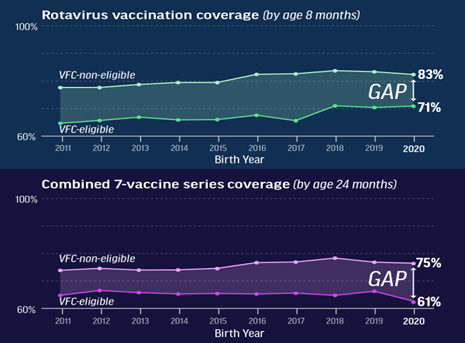Vaccine Update: Vaccines for Children - Millions of Lives Saved and Counting
Column Author: Maria Martinez RN, BSN, MSN, MBA, CPN
Column Editor: Angela L. Myers, MD, MPH | Division Director, Infectious Diseases; Medical Director, Center for Wellbeing
With over 1.1 million lives saved, the Vaccines for Children (VFC) program has been one of the biggest successes for public health in the United States since the program’s initiation in 1994. Additionally, it’s estimated that through vaccination the program helped prevent 508 million illnesses and 32 million hospitalizations from 1994 to 2023.1 This is estimated as a savings of 2.7 trillion in societal costs.2 Cost savings included deaths averted, medical bills from lifelong complications, days children didn’t miss school, and time parents didn’t have to miss work by providing care.3
VFC was established in 1994 by Congress after a measles resurgence. (Figure 1) The national resurgence of measles from 1989 to 1991 disproportionally impacted several demographics. Those at highest risk were inner city, preschool-aged Native American, Hispanic or Black children under the age of 5 who were unvaccinated and living in poverty. Cost was identified as one of the biggest barriers to vaccination. The VFC program was established in October of 1994 to provide qualified children with publicly purchased vaccines at no cost. These VFC doses could be administered at clinics or health departments of providers enrolled in the VFC program.4
VFC eligibility:
- Anyone age 18 or younger who meets any of the following criteria:
- Medicaid eligible
- Uninsured
- Underinsured
- Native American or Alaskan Native

Figure 1. Measles Cases and Outbreaks | Measles (Rubeola) | CDC
Data from the National Immunization Surveys and school vaccination surveys provided estimates for how many children have been vaccinated. Data from the National Notifiable Diseases Surveillance System provided estimates of disease cases and deaths. It’s estimated that approximately 5,000 tetanus cases and 100 million measles and varicella cases were prevented. Nearly 90% of children VFC-eligible born in 2020, received their measles, mumps and rubella (MMR) vaccine.5
While the VFC program has been a huge success in increasing vaccination rates, there is still a disparity between vaccination rates for those who are VFC eligible and those who are non-eligible. Those who are VFC non-eligible had 75% coverage (by 24 months of age) for the combined 7-vaccine series versus those who were VFC eligible, who had 61% coverage. (Figure 2) Coverage was highest for single doses of vaccines and those given earlier in life. Vaccines that required multiple doses, in particular doses recommended after 12 months of age, had the lowest coverage. Children living below the poverty level and children who were uninsured had the lowest coverage rates.1

Figure 2. Vaccines for Children (VFC) Program 30 Years of Protecting Children | VitalSigns | CDC
Healthcare providers can help by:
- Establishing trusting relationships with families and taking the time to answer questions
- Providing education on the benefits of vaccines along with a strong recommendation
- Using reminders for upcoming appointments and missed vaccination appointments
- Participating in the VFC program1
References:
- Vaccines for Children (VFC) program: 30 years of protecting children. Centers for Disease Control and Prevention. Updated August 29, 2024. Accessed September 2, 2024. https://www.cdc.gov/vitalsigns/vaccines-for-children/index.html
- Valier MR, Yankey D, Elam-Evans LD, et al. Vital signs: trends and disparities in childhood vaccination coverage by Vaccines for Children program eligibility - National Immunization Survey-Child, United States, 2012-2022. MMWR Morb Mortal Wkly Rep. 2024;73(33):722-730. Accessed August 28, 2024. https://www.cdc.gov/mmwr/volumes/73/wr/mm7333e1.htm
- Cuevas E. How routine vaccines will prevent 1.1 million deaths, save $2.7 trillion. USA Today. Updated August 8, 2024. Accessed August 28, 2024. https://www.usatoday.com/story/news/health/2024/08/08/childrens-vaccine-program-saved-lives/74719119007/
- Smith PJ, Lindley MC, Rodewald LE. Vaccination coverage among U.S. children aged 19-35 months entitled by the Vaccines for Children program, 2009. Public Health Rep. 2011;126 Suppl 2(Suppl 2):109-123. Accessed September 2, 2024. https://www.ncbi.nlm.nih.gov/pmc/articles/PMC3113436/
- Howard J. Childhood vaccinations will have prevented more than 500 million illnesses and 1 million deaths in US since 1994, CDC report says. CNN. Updated August 8, 2024. Accessed August 18, 2024. https://us.cnn.com/2024/08/08/health/childhood-vaccines-prevent-hospitalizations-deaths/index.html